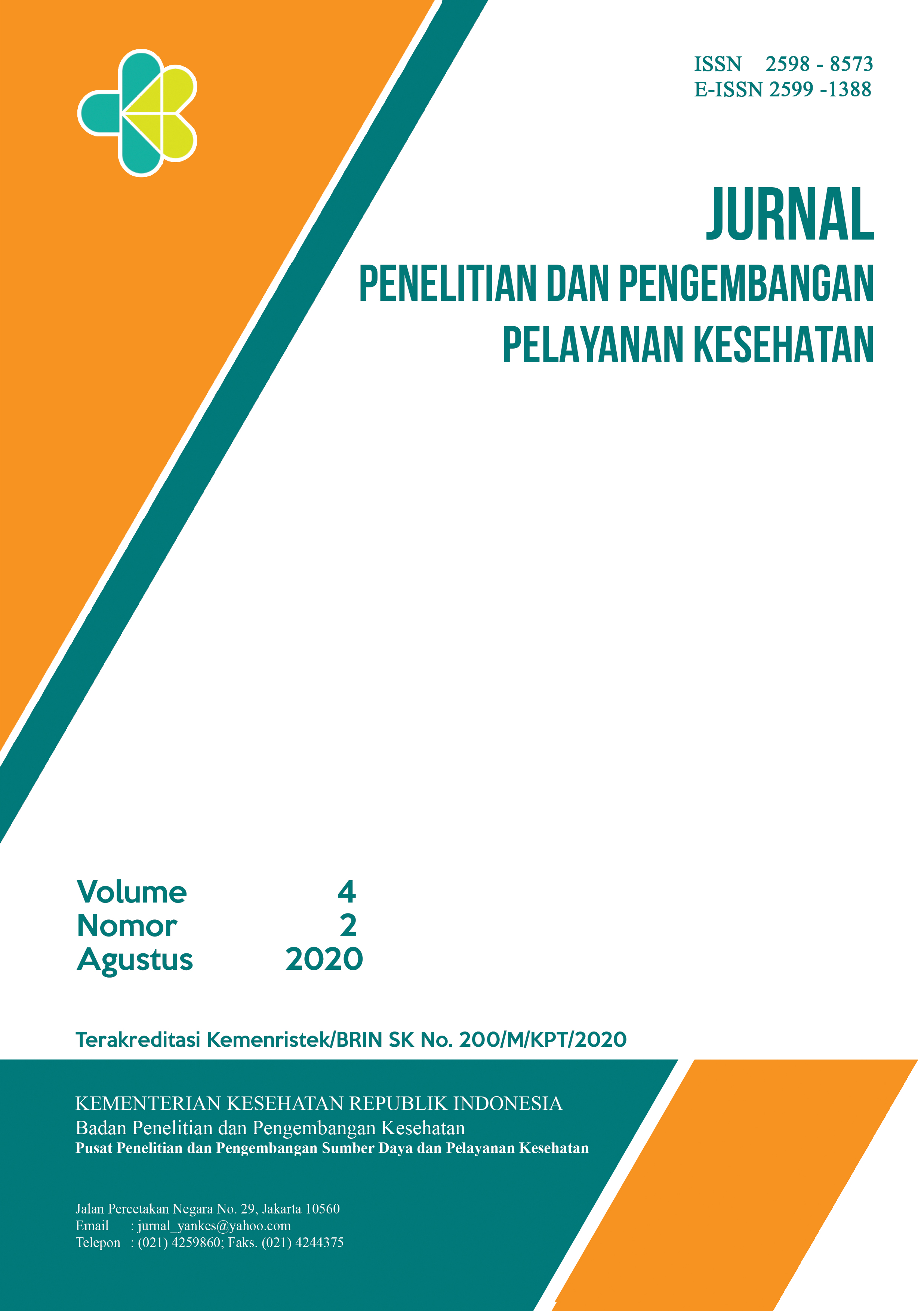Metode Estimasi Hemoglobin pada Situasi Sumberdaya Terbatas: Kajian Pustaka
Abstract
Abstrak
Ada beberapa teknik untuk mengestimasi Hemoglobin (Hb) yang telah tersedia secara komersial. Sebagian besar metode ini tidak cocok untuk kondisi di negara berkembang dengan keterbatasan sumber daya, terutama karena harga pembelian peralatan yang tinggi atau biaya operasional yang tinggi. Kajian ini dilakukan untuk meninjau metode estimasi Hb yang dapat dilakukan pada situasi seumberdaya terbatas dari perspektif negara berkembang. Kajian pustaka dilakukan melalui database PubMed untuk studi-studi yang membandingkan berbagai teknik estimasi Hb. Kajian ini mendapatkan 13 artikel yang dimasukkan dalam kajian ini. Mengestimasi Hb pada kondisi yang sumberdayanya terbatas diperlukan metode yang ekonomis, praktis, cepat, valid, dan handal. Cyanmethemoglobin langsung telah menjadi gold-standard untuk estimasi hemoglobin, tetapi metode lain seperti Haemoglobin Color Scale (HCS), teknik Sahli, teknik Lovibond-Drabkin, teknik Tallqvist, metode tembaga-sulfat, HemoCue®, dan Automated Haematology Analyzer (AHA) juga tersedia. Setiap metode memiliki prinsip kerja yang berbeda dan kelebihan serta kekurangannya masing-masing. HemoCue® adalah metode terbaik untuk skrining awal anemia karena dapat diandalkan, mudah dibawa, tidak memerlukan catu daya dan mudah digunakan dikondisi sumber daya yang kurang tanpa perlu melatih petugas kesehatan. HCS adalah metode potensial lain yang dapat digunakan dalam situasi kekurangan sumber daya. Namun, metode tersebut harus diselidiki lebih lanjut melalui studi yang lebih besar sebelum diimplementasikan.
Kata kunci: Metode estimasi hemoglobin
Abstract
There are several techniques for estimating Hemoglobin (Hb) that are commercially available. Most of these methods are not suitable for conditions in developing countries with limited resources, mainly due to equipment prices or high operational costs. This study was conducted to review the methods of estimating Hb which can be carried out in limited resource situations from the perspective of developing countries. A literature review was carried out through the PubMed database for studies comparing various Hb estimation techniques. Results of the literature review, 13 articles were included in this review. Hb estimation in limited resources situations required methods that are not expensive, practical, quick, valid, and reliable. Direct cyanmethemoglobin has become the gold standard for estimating hemoglobin, but other methods such as Hemoglobin Color Scale (HCS), Sahli technique, Lovibond-Drabkin technique, Tallqvist technique, copper-sulfate method, HemoCue®, and Automated Hematology Analyzer (AHA) are also available. Each method has a different working principle and its advantages and disadvantages. HemoCue® is the choice method for initial screening of anemia because it is reliable, portable, does not require a power supply and is easy to use in poor resource conditions without requiring health worker’s training. HCS is another potential method that can be used in limited resource situations. However, these methods must be further investigated through larger studies before it’s implementation.
Keywords: Haemoglobin estimation method
References
Zwart A. van Assendelft OW. Bull BS. England JM. Lewis SM. Zijlstra WG. Recommendations for reference method for haemoglobinometry in human blood (ICSH standard 1995) and specifications for international haemiglobinocyanide standard. J Clin Pathol. (4th ed) 1996;49:271–4. [PMCID: PMC500441] [PubMed:8655699]
Faatih M. et al. Penggunaan alat pengukur hemoglobin di Puskesmas, Polides dan Pustu. Jurnal Penelitian dan Pengembangan Pelayanan Kesehatan. 2017 Agu;1(1):32-29.
Hofland H.J. Point of care testing and selftest related consultations in general practices in the Netherlands: an exploratory study on general practitioners’ experiences. HTSR Netherland Juli 2011.
Sprong L. Quality assurance for the POCT system. Central Laboratory, Sumperc Hospital, Czech Republic. 2011.
Zhou X. Yan H. Xing Y. Dang S. Zhuoma B. Wang D. Evaluation of a portable hemoglobin photometer in pregnant women in a high altitude area: a pilot study. BMC Public Health. 2009;9: 228. https://doi.org/10.1186/1471-2458-9-228.
Bansal PG. et al. Comparison of haemoglobin estimates using direct & indirect cyanmethaemoglobin methods. Indian J Med Res. 2016 Oct;144(4):566–571.
Marn H. Critchley JA. Accuracy of the WHO haemoglobin colour scale for the diagnosis of anaemia in primary health-care settings in low-income countries: a systematic review and meta-analysis. Lancet Glob Health. 2016;4:e251–65. http://dx.doi.org/10.1016/S2214-109X(16)00050-4.
Hiscock R. Kumar D. Simmons S. W. Systematic review and meta-analysis of method comparison studies of Masimo pulse co-oximeters (Radical-7™ or Pronto-7™) and HemoCue® absorption spectrometers (B-Hemoglobin or 201+) with laboratory haemoglobin estimation. Anaesth Intensive Care. 2015;43(3).
van Lerberghe W. Keegels G. Cornelis G. Ancona C. Mangelschots E. van Balen H. Haemoglobin measurement: the reliability of some simple techniques for use in a primary health care setting. Bull World Health Organ. 1983;61:957-965.
Wasiu Olalekan A. Olufemi Emmanuel A. How valid is the tallquist method in screening pregnant women with anemia in poor rural settings of southwestern Nigeria? Med J Islam Repub Iran. 2016;30:389.
Antwi-Baffour et al. Anemia in prospective blood donors deferred by the copper sulphate technique of hemoglobin estimation. BMC Hematology. 2015;15(15). https://doi.org/10.1186/s12878-015-0035-3.
Sawant RB. Bharucha ZS. Rajadhyaksha SB. Evaluation of hemoglobin of blood donors deferred by the copper sulphate method for hemoglobin estimation. Transfus Apher Sci. 2007 Apr;36(2):143-8.
Whitehead RD Jr. Mei Z. Mapango C. Jefferds MED. Methods and analyzers for hemoglobin measurement in clinical laboratories and field settings. Ann N Y Acad Sci. 2019 Aug;1450(1):147-171. https://doi.org/10.1111/nyas.14124.
Hill VL. Simpson VZ. Higgins JM. Hu Z. Stevens RA. Metcalf JA. et al. Evaluation of the performance of the Sysmex XT-2000i hematology analyzer with whole bloods stored at room temperature. Lab Med 2009;40(12):709-712.
Srivastava T. Negandhi H. Neogi SB. Sharma J. Saxena R. Methods for hemoglobin estimation; a review of “what works”. J Hematol Transfus 2014;2(3):1028 pp1-7.
Sanchis-Gomar F. Cortell-Ballester J. Pareja-Galeano H. Banfi G. Lippi G. Hemoglobin point-of-care testing: the HemoCue system. J Lab Autom. 2013;18:198-205.
Mills AF. Meadows N. Screening for anaemia: evaluation of a haemoglobinometer. Arch Dis Child. 1989;64:1468-1471.
Tyrrell A. Worrall E. Que TN. Bates I. Cost and effectiveness comparison of two methods for screening potential blood donors for anaemia in Vietnam. Transfus Med. 2011;21:158-165.



